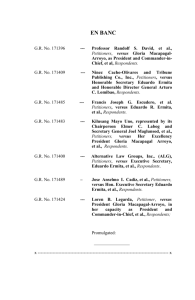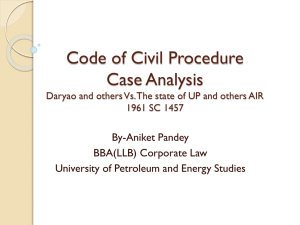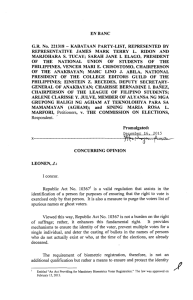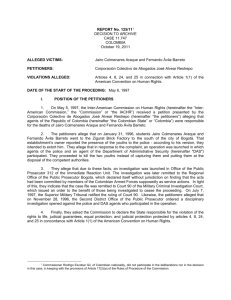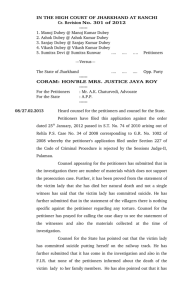represented by Lauro de Leon, President
advertisement
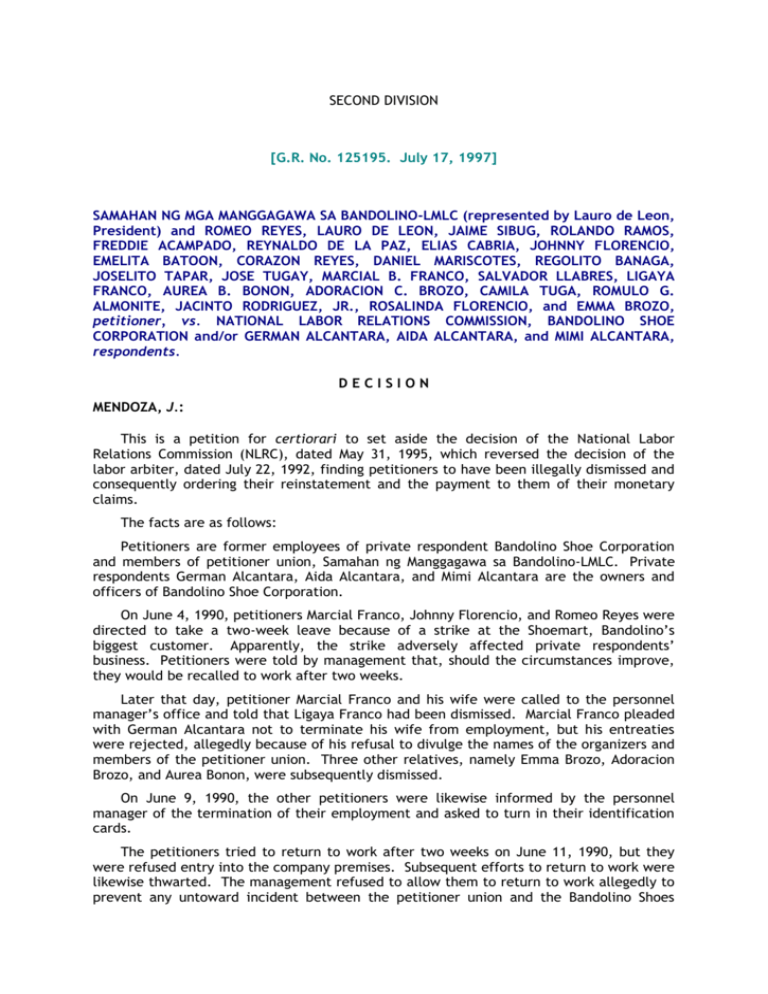
SECOND DIVISION [G.R. No. 125195. July 17, 1997] SAMAHAN NG MGA MANGGAGAWA SA BANDOLINO-LMLC (represented by Lauro de Leon, President) and ROMEO REYES, LAURO DE LEON, JAIME SIBUG, ROLANDO RAMOS, FREDDIE ACAMPADO, REYNALDO DE LA PAZ, ELIAS CABRIA, JOHNNY FLORENCIO, EMELITA BATOON, CORAZON REYES, DANIEL MARISCOTES, REGOLITO BANAGA, JOSELITO TAPAR, JOSE TUGAY, MARCIAL B. FRANCO, SALVADOR LLABRES, LIGAYA FRANCO, AUREA B. BONON, ADORACION C. BROZO, CAMILA TUGA, ROMULO G. ALMONITE, JACINTO RODRIGUEZ, JR., ROSALINDA FLORENCIO, and EMMA BROZO, petitioner, vs. NATIONAL LABOR RELATIONS COMMISSION, BANDOLINO SHOE CORPORATION and/or GERMAN ALCANTARA, AIDA ALCANTARA, and MIMI ALCANTARA, respondents. DECISION MENDOZA, J.: This is a petition for certiorari to set aside the decision of the National Labor Relations Commission (NLRC), dated May 31, 1995, which reversed the decision of the labor arbiter, dated July 22, 1992, finding petitioners to have been illegally dismissed and consequently ordering their reinstatement and the payment to them of their monetary claims. The facts are as follows: Petitioners are former employees of private respondent Bandolino Shoe Corporation and members of petitioner union, Samahan ng Manggagawa sa Bandolino-LMLC. Private respondents German Alcantara, Aida Alcantara, and Mimi Alcantara are the owners and officers of Bandolino Shoe Corporation. On June 4, 1990, petitioners Marcial Franco, Johnny Florencio, and Romeo Reyes were directed to take a two-week leave because of a strike at the Shoemart, Bandolino’s biggest customer. Apparently, the strike adversely affected private respondents’ business. Petitioners were told by management that, should the circumstances improve, they would be recalled to work after two weeks. Later that day, petitioner Marcial Franco and his wife were called to the personnel manager’s office and told that Ligaya Franco had been dismissed. Marcial Franco pleaded with German Alcantara not to terminate his wife from employment, but his entreaties were rejected, allegedly because of his refusal to divulge the names of the organizers and members of the petitioner union. Three other relatives, namely Emma Brozo, Adoracion Brozo, and Aurea Bonon, were subsequently dismissed. On June 9, 1990, the other petitioners were likewise informed by the personnel manager of the termination of their employment and asked to turn in their identification cards. The petitioners tried to return to work after two weeks on June 11, 1990, but they were refused entry into the company premises. Subsequent efforts to return to work were likewise thwarted. The management refused to allow them to return to work allegedly to prevent any untoward incident between the petitioner union and the Bandolino Shoes Independent Labor Union. On June 11, 1990, petitioners filed a notice of strike. A conciliation conference was held but it was unsuccessful. Although petitioners did not strike, they staged a picket for one hour each on two successive Saturdays to protest their dismissal. On August 22, 1990, they filed a complaint for illegal dismissal, unfair labor practice, underpayment, overtime pay, and holiday pay. At the initial conference, the labor arbiter issued a return to work order to the private respondents based on the private respondents’ claim that they had not dismissed petitioners. But petitioners were not allowed to work by private respondents. The labor arbiter’s efforts to get the parties to settle their dispute amicably proved unavailing, as the private respondents imposed conditions unacceptable to petitioners. As private respondents themselves stated in their position paper dated November 27, 1990, “management was willing to allow complainants to report for work immediately . . . if complainants were willing to forego their strike and Petition for Certification and to recognize the majority representation status of the existing Union (then uncertified),” but they were not. On July 22, 1992, the Labor Arbiter, Potenciaño S. Cañizares, Jr., decided the case in favor of petitioners. He found that petitioners had been illegally dismissed because of their union activities and that private respondents had committed unfair labor practice. Although private respondents claimed to have merely placed petitioners on “rotation” because of the Shoemart strike, the labor arbiter found that even after the end of the strike, petitioners were still not allowed to return to work. Referring to private respondents’ position paper, the labor arbiter found that private respondents had imposed illegal conditions on petitioners’ reinstatement by requiring them to forego their intended strike, withdraw their petition for certification election, and instead recognize the existing union. On this basis and noting that during the hearings private respondents’ counsel subjected the petitioners to a barrage of questioning regarding their union activities, the labor arbiter concluded that private respondents were guilty of unfair labor practice for having restrained the petitioners’ exercise of the right to self-organization. Accordingly, the labor arbiter ordered: WHEREFORE, judgment is hereby rendered: 1. Declaring the respondents guilty of unfair labor practice and ordering the respondents to cease and desist from further committing the ULP acts as charged; 2. Ordering the respondents to reinstate the complainants in their previous jobs and to pay them backwages for one (1) year without qualifications or deductions for earning elsewhere during their illegal dismissal. The aspect of reinstatement, either in the job or payroll at the option of the respondents, pursuant to Article 223 of the Labor Code, being immediately executory, the respondents are hereby directed to reinstate the complainants either way upon their presentation of themselves for work. 3. Ordering the respondents to pay the complainants salary differential and legal holiday pay. The following are the monetary awards as computed by Ma. Cristina T. Paraoan of the Commission’s Research and Information Unit: 1. ROMULO ALMONTE P43,087.76 2. REGOLITO BAÑAGA 53,953.93 3. EMELITA BATOON 43,533.46 4. ELIAS ECABRIA 42,229.72 5. LAURO DE LEON 45,499.32 6. NILDA DELGADO 32,625.72 7. JOHNNY FLORENCIO 45,499.72 8. MARCIAL FRANCO 43,147.72 9. SALVADOR LLABRES 44,915.32 10.ROSALINA FLORENCIO 37,564.85 11.DANIEL MARISCOTES 44,639.72 12.ROLANDO MATRE 44,713.52 13.VIRGINIA PEDRACIO 54,498.96 14.ROLANDO RAMOS 44,772.60 15.CORAZON REYES 58,868.46 16.ROMEO REYES 56,779.27 17.JACINTO RODRIGUEZ, JR. 37,674.12 18.CAROLINA SANTIAGO 35,257.14 19.JAIME SIBUG 20.MARITA SORIANO 21.CAMILA TUGAY 32,453.72 37,900.72 39,046.68 The claim for overtime pay is hereby dismissed for lack of sufficient evidence. Pursuant to the decision of the labor arbiter, private respondents sent telegrams, dated August 29, 1992, to the petitioners ordering them to REPORT TO WORK IMMEDIATELY AT 131 LOPEZ JAENA ST. JESUS DELA PEÑA, MARIKINA. FAILURE TO DO SO WITHIN TEN (10) DAYS SHALL BE INTERPRETED THAT YOU ARE NO LONGER INTERESTED TO WORK HERE.<!--[if !supportFootnotes]-->[1]<!-[endif]--> In a letter dated September 3, 1992, petitioners responded, thus: While all the complainants are ready and willing to return to work at the soonest time possible and while we do not in any way reject the scheduled reinstatement, it may not be possible within the time frame stated by you in the telegram. Inasmuch as there are more than four members of the union, in fact more than twenty (20), who are entitled to reinstatement; and inasmuch as there are other aspects of the decision of the labor arbiter covering the above-stated case which have to be discussed, we hereby propose that a conference be held between the arbiter, the union leaders and managements’ representatives in order that all concerned will be able to thresh out these matters and prepare for a smooth and amicable implementation of the decision in the above-mentioned case. In this connection, a motion for immediate execution of the decision of the arbiter has been filed in behalf of the complainant and a conference on the basis of this motion will be set by Arbiter Cañizares to be held before him at the NLRC. A copy of the motion has been sent you and your office will be notified of the date of the conference.<!--[if !supportFootnotes]-->[2]<!--[endif]--> In response, private respondents wrote: We are of the considered opinion that, since you have already admitted in behalf of the complainants that they are ready and willing to report for work and do not reject the scheduled reinstatement, there is no justifiable reason why they should not immediately return to work and cause unnecessary delay. .... Considering that both parties have already appealed the decision and that respondent has already posted a surety bond, nothing is left then to be done but to follow the legitimate order of Bandolino’s management for the return of the complainants. The request for a conference, to be mediated by the Honorable Arbiter Cañizares is not necessary since once an order has been appealed, the Honorable Arbiter loses his jurisdiction. And, considering further, that two (2) months have already lapsed from the time the decision was promulgated and more than a month from the time the telegram was sent individually, the interest and desire to return to work by your clients is surely doubtful and highly questionable.<!--[if !supportFootnotes]-->[3]<!--[endif]--> Private respondents appealed to the NLRC, contending that the “rotation” of petitioners was not a termination of employment; that petitioners did not report for work although they had been reinstated; and that the labor arbiter’s finding that the company imposed illegal conditions was based upon an “off the record” offer which was privileged in nature and therefore could not be used in evidence against private respondents. According to private respondents, petitioners’ lay off because of the “rotation” scheme could not be considered union busting because it was adopted in 1989, before the registration of petitioner union as an affiliate of Lakas ng Manggagawa Labor Center (LMLC) on November 7, 1990. They contended that the monetary awards had no basis. In its decision dated May 31, 1995, the NLRC reversed the labor arbiter. It ruled that except for Jaime Sibug, petitioners were all piece-rate workers entitled only to 13th month pay for three years. It held further that there was no evidence showing specific instances of coercion or restraint committed by the private respondents to justify a finding of ULP. The NLRC gave credence instead to private respondents’ claim that, at the time the “rotation scheme” was implemented, they did not know that petitioner union was registered or that the petitioners were the organizers; and that petitioners misrepresented that their union was a member of the LMLC, when in fact it was only on November 7, 1990 that they affiliated with the LMLC. The NLRC found that petitioners organized a union only after the implementation of the 1990 “rotation scheme.” The NLRC agreed with the private respondents’ claim that the “off the record” offer made by them constitutes privileged communication and that under Art. 233 of the Labor Code it cannot be taken in evidence against them. The NLRC therefore ruled that “There being no other evidence to support the claim of ULP, such finding must be overturned.” Hence, this petition. Petitioners contend that the NLRC acted with grave abuse of discretion in reversing the labor arbiter’s findings. They contend that the labor arbiter’s decision finding that they had been illegally dismissed is supported by other evidence and not only the conditions attached to the offer, namely (1) that petitioners’ non-reinstatement even after the end of the Shoemart strike contradicts the claim of private respondents that petitioners were merely put on “rotation” because business was poor on account of the Shoemart strike and (2) that the order to petitioners to turn in their ID cards implied termination of their employment. Petitioners also maintain that the offer of reinstatement made by private respondents at the hearing was properly used as evidence of ULP because private respondents themselves adverted to the offer in their position paper and therefore took the conditions attached to their offer out of the ambit of privileged communication. They contend finally that it was error for the NLRC to rule that private respondents did not commit unfair labor practice because, at that time, there was yet no union of petitioners. Petitioners contend that under the ruling in Judric Canning Corp. v. Inciong,<!--[if !supportFootnotes]-->[4]<!--[endif]--> restraint or coercion may be employed even prior to the registration of a union. While generally speaking factual findings of administrative agencies are not subject to review by this Court, it is equally established that the Court will not uphold erroneous conclusions which are contrary to the evidence because then the agency would be guilty of a grave abuse of discretion. Nor is this Court bound by conclusions which are not supported by substantial evidence.<!--[if !supportFootnotes]-->[5]<!--[endif]--> The substantial evidence rule does not authorize any finding to be made just as long as there is any evidence to support it. It does not excuse administrative agencies from considering contrary evidence which fairly detracts from the evidence supporting a finding. In this case, the labor arbiter’s finding of illegal dismissal was based not only upon the private respondents’ “off the record” offer containing illegal conditions but also on facts of record found by the arbiter which the NLRC disregarded. These are: (1) that following the order for “rotation,” some of the petitioners were made to surrender their IDs and (2) that although the “rotation scheme” was ostensibly implemented because of the Shoemart strike, even after the strike had ended, petitioners’ attempts to return to work were thwarted. In truth, private respondents’ claim that petitioners, who were regular employees, were put on rotation while the casual workers were not because petitioners were skilled and it was much easier for them to find new jobs only succeeds in revealing their real intention. Would it be necessary for petitioners to look for new jobs if the “rotation” was merely temporary? The NLRC plainly ignored these facts which amply supported the labor arbiter’s decision. It is untenable for the Solicitor General to contend,<!--[if !supportFootnotes]-->[6]<!--[endif]--> that petitioners were dismissed for their refusal to return to work. Petitioners did not refuse to work. They responded promptly to private respondents’ telegrams and expressed their intention to resume work immediately. This is clear from their letter to the management on September 3, 1992<!--[if !supportFootnotes]-->[7]<!--[endif]--> as quoted above. Moreover, it has been ruled that mere failure to report for work after notice to return does not constitute abandonment or bar reinstatement.<!--[if !supportFootnotes]-->[8]<!--[endif]--> Thus, petitioners may even be considered dismissed without cause as a result of private respondents’ refusal to accept them, in addition to having been earlier dismissed by being put on “rotation.” To repeat, even disregarding evidence of the illegal conditions imposed by private respondents for petitioners’ return to work, there was substantial evidence remaining in the record to sustain the labor arbiter’s decision that private respondents were guilty of ULP. There was evidence to the effect that Marcial Franco had been asked to disclose the names of the members of the union and that the management had shown interest in the unionizing activities of the petitioners. This evidence has remained unchallenged.<!--[if !supportFootnotes]-->[9]<!--[endif]--> What is more, it appears that only alleged members of the petitioner union were put on “rotation.”<!--[if !supportFootnotes]-->[10]<!--[endif]--> The labor arbiter’s observation during the hearing that the private respondents had shown hostility towards petitioners for their union activities is a determination of fact which is based on the totality of private respondents’ conduct, indicating anti-union bias.<!--[if !supportFootnotes]-->[11]<!-[endif]--> Nor is it disputed that private respondents opposed petitioners’ petition for certification election when this matter should be the sole concern of the workers.<!--[if !supportFootnotes]-->[12]<!--[endif]--> Private respondents’ interest belies their claim that they were not aware of petitioners’ organizational and union activities prior to the union’s registration. An employer may be guilty of ULP in interfering with the right to selforganization even before the union has been registered.<!--[if !supportFootnotes]-->[13]<!--[endif]--> We therefore proceed to petitioners’ prayer for monetary awards. Petitioners do not dispute the NLRC’s finding that, except for Jaime Sibug, the rest of petitioners are piecerate workers. Consequently, all petitioners are entitled to minimum wage and 13th-month pay, but only Jaime Sibug is entitled to an additional award of holiday pay. All of the petitioners are entitled to salary differentials, as found by the labor arbiter, and to 13thmonth pay, as ruled by the NLRC. Pursuant to Art. 279 of the Labor Code, as amended by Republic Act No. 6715, and our ruling in Bustamante v. National Labor Relations Commission,<!--[if !supportFootnotes]-->[14]<!--[endif]--> the petitioners are entitled to full backwages from the time their compensation was withheld up to the time of their actual reinstatement or, where reinstatement is no longer possible, to full backwages up to the time of finality of this decision. WHEREFORE, in view of the foregoing, the decision of the NLRC dated May 31, 1995 is set aside and the decision of the labor arbiter dated July 22, 1992 is reinstated, with the modification that only Jaime Sibug should be given holiday pay, while all petitioners should be given 13th-month pay and full backwages. SO ORDERED. Regalado, (Chairman), Romero and Puno, JJ., concur. Torres, Jr., J., on leave. <!--[if !supportEndnotes]--> <!--[endif]--> <!--[if !supportFootnotes]-->[1]<!--[endif]--> Rollo, p. 42. <!--[if !supportFootnotes]-->[2]<!--[endif]--> Id., pp. 42-43. <!--[if !supportFootnotes]-->[3]<!--[endif]--> Id., pp. 43-44. <!--[if !supportFootnotes]-->[4]<!--[endif]--> 115 SCRA 887 (1982). <!--[if !supportFootnotes]-->[5]<!--[endif]--> Labor v. National Labor Relations Commission, 248 SCRA 183 (1995). <!--[if !supportFootnotes]-->[6]<!--[endif]--> Comment, p. 9; Rollo, p. 144. <!--[if !supportFootnotes]-->[7]<!--[endif]--> Rollo, pp. 42-43. <!--[if !supportFootnotes]-->[8]<!--[endif]--> The Insular Life Assurance Co., Ltd. Employees AssociationNATU v. The Insular Life Assurance Co., Ltd., 37 SCRA 244 (1971). <!--[if !supportFootnotes]-->[9]<!--[endif]--> Ibid. <!--[if !supportFootnotes]-->[10]<!--[endif]--> Manila Pencil Co., Inc. v. Court of Industrial Relations, 14 SCRA 955 (1965). <!--[if !supportFootnotes]-->[11]<!--[endif]--> The Insular Life Assurance Co., Ltd. Employees AssociationNATU v. The Insular Life Assurance Co., Ltd., 37 SCRA 244. <!--[if !supportFootnotes]-->[12]<!--[endif]--> Golden Farms, Inc. v. Secretary of Labor, 234 SCRA 517 (1994); Philippine Telegraph and Telephone Corp. v. Laguesma, 223 SCRA 452 (1993). <!--[if !supportFootnotes]-->[13]<!--[endif]--> Judric Canning Corp. v. Inciong, 115 SCRA 887. <!--[if !supportFootnotes]-->[14]<!--[endif]--> G.R. No. 111651, November 28, 1996.
